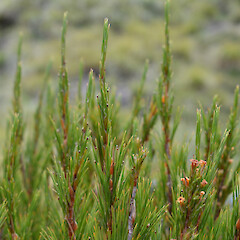Dracophyllum rosmarinifolium
Common name
common grass tree, inaka
Synonyms
Epacris rosmarinifolia Forst.f.; Dracophyllum uniflorum Hook.f.
Family
Ericaceae
Flora category
Vascular – Native
Endemic taxon
Yes
Endemic genus
No
Endemic family
No
Structural class
Trees & Shrubs - Dicotyledons
NVS code
The National Vegetation Survey (NVS) Databank is a physical archive and electronic databank containing records of over 94,000 vegetation survey plots - including data from over 19,000 permanent plots. NVS maintains a standard set of species code abbreviations that correspond to standard scientific plant names from the Ngä Tipu o Aotearoa - New Zealand Plants database.
DRAROS
Chromosome number
2n = 26
Current conservation status
The conservation status of all known New Zealand vascular plant taxa at the rank of species and below were reassessed in 2017 using the New Zealand Threat Classification System (NZTCS) – more information about this can be found on the NZTCS website. This report includes a statistical summary and brief notes on changes since 2012 and replaces all previous NZTCS lists for vascular plants.
Please note, threat classifications are often suggested by authors when publications fall between NZTCS assessment periods – an interim threat classification status has not been assessed by the NZTCS panel.
- Conservation status of New Zealand indigenous vascular plants, 2017 . 2018. Peter J. de Lange, Jeremy R. Rolfe, John W. Barkla, Shannel P. Courtney, Paul D. Champion, Leon R. Perrie, Sarah M. Beadel, Kerry A. Ford, Ilse Breitwieser, Ines Schönberger, Rowan Hindmarsh-Walls, Peter B. Heenan and Kate Ladley. Department of Conservation. Source: NZTCS and licensed by DOC for reuse under the Creative Commons Attribution 4.0 International licence.
2017 | Not Threatened
Previous conservation statuses
2012 | Not Threatened
2009 | Not Threatened
2004 | Not Threatened
Brief description
Grassy reddish or green often sprawling shrub with many erect twigs bearing clusters of narrow pointed leaves that point away from the stem and that sheath the stem at their base. Leaves 8.5-40mm long by 0.5 to 1.5mm wide. Flowers solitary, at tip of short side branches.
Distribution
Endemic. New Zealand: North (Tararua Ranges) and South Islands (throughout the South Island)
Habitat
Dracophyllum rosmarinifolium is a shrub inhabiting montane woodland and shrubland to subalpine or alpine grassland, herbfield, fellfield or bog land within mountain gullies, mountain slopes and ridges, bluffs, plateaus and also valley floors.
Detailed description
Multi–stemmed shrub 0.3–1.0 m tall. Branches erect to spreading and much–branched. Bark on old branches grey to dark grey, finely to deeply fissured, young stems reddish brown. Leaves erect to spreading, light to olive green; lamina sheath 2.0–8.5 × 2.5–4.0 mm; shoulders rounded to truncate and margins membranous, ciliate; lamina 8.0–55.0 × 0.59–1.5 mm linear to linear–subulate; adaxial surface glabrous, occasionally rugose, with a tuft of short scabrid hairs at base; margins serrulate with 70–80 teeth per 10 mm; apex obtuse to acute and triquetrous. Inflorescence a terminal solitary erect flower; shorter than leaves; inflorescence bract shorter to equaling flower, 5.0–13.0 × 1.0–2.0 mm, narrowly ovate–lanceolate at base, adaxial surface scabrid at base; margins serrulate. Flowers sessile. Sepals 4.5–12.0 × 1.2–2.5 mm, lanceolate to ovate–lanceolate, equaling to longer than corolla tube, top half rarely shortly pubescent; margins ciliate. Corolla white turning pale yellow with age, occasionally light pink; corolla tube 4.0–7.0 × 1.5–2.0 mm, cylindrical; corolla lobes reflexed, 2.0–2.5 × 1.2–2.0 mm, triangular, shorter than corolla tube, apex inflexed, subacute to acute; apical ridge present, adaxial surface papillate. Stamens inserted on corolla tube in the upper third, filaments 0.3–0.5 mm long; anthers included, 0.7–1.0 mm long, oblong, initially pink turning light yellow. Ovary 1.7–2.0 × 1.0–2.0 mm, obovate, apex round; nectary scales 0.7–1.5 × 0.4–0.7 mm rectangular, apices retuse to irregularly toothed; style included, 1.5–2.5 mm long, glabrous, not lengthening in fruit; stigma capitate. Fruit 3.7–4.0 × 3.8–4.0 mm, obovoid, light brown, apex round, glabrous. Seeds 0.8 – 1.0 mm long yellowish brown, ovoid, with the testa slightly reticulate.
Similar taxa
Dracophyllum rosmarinifolium is recognised by the non-pendulous erect to much-branched spreading growth habit, linear spreading leaves, solitary flowers that terminate short branchlets, sepals equaling or longer than the corolla tube, prominent apical ridge on the corolla lobes, inflexed corolla lobe apex and an obovoid ovary. Dracophyllum rosmarinifolium is most similar to D. uniflorum var. frondosum from which but differs in having erect to spreading not arching, to decumbent or pendulous branches; inflorescence bracts that equal the flower length but do not exceed them; sepals which are longer than the corolla tube (never equal to them) and by the corolla tube which is is shorter (5–7 mm compared to 7–10 mm in D. uniflorum var. frondosum).
Flowering
October – May
Fruiting
December - August
Life cycle
Minute seeds are wind dispersed (Thorsen et al., 2009).
Propagation technique
Difficult - should not be removed from the wild
Etymology
dracophyllum: Dragon leaf, from its likeness to the dragon tree of the Canary Islands
rosmarinifolium: Rosemary leaf
Where To Buy
Not commercially available.
Attribution
Fact sheet prepared for NZPCN by P.J. de Lange (6 June 2012). Description adapted from Venter (2009)
References and further reading
Venter, S. 2009: A taxonomic revision of the genus Dracophyllum Labill. (Ericaceae). Unpublished Phd Thesis, Victoria University of Wellington, Wellington.
Thorsen, M. J.; Dickinson, K. J. M.; Seddon, P. J. 2009. Seed dispersal systems in the New Zealand flora. Perspectives in Plant Ecology, Evolution and Systematics 11: 285-309
NZPCN Fact Sheet citation
Please cite as: de Lange, P.J. (Year at time of access): Dracophyllum rosmarinifolium Fact Sheet (content continuously updated). New Zealand Plant Conservation Network. https://www.nzpcn.org.nz/flora/species/dracophyllum-rosmarinifolium/ (Date website was queried)






